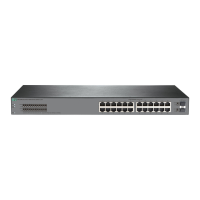146
Enabling stateless address autoconfiguration
1. Enter system view.
system-view
2. Enter interface view.
interface interface-type interface-number
3. Enable stateless address autoconfiguration on an interface, so that the interface can
automatically generate a global unicast address.
ipv6 address auto
By default, the stateless address autoconfiguration feature is disabled on an interface.
Configuring the temporary address feature and preferentially using the temporary IPv6
address as the source address of outgoing packets
1. Enter system view.
system-view
2. Enable the temporary IPv6 address feature.
ipv6 temporary-address [ valid-lifetime preferred-lifetime ]
By default, the temporary IPv6 address feature is disabled.
3. Enable the system to preferentially use the temporary IPv6 address as the source address of
the outgoing packets.
ipv6 prefer temporary-address
By default, the system does not preferentially use the temporary IPv6 address as the source
address of the outgoing packets.
Configuring prefix-specific address autoconfiguration
1. Enter system view.
system-view
2. Configure an IPv6 prefix.
Choose one option as needed:
{ Configure a static IPv6 prefix.
ipv6 prefix prefix-number ipv6-prefix/prefix-length
By default, no static IPv6 prefixes exist.
{ Use DHCPv6 to obtain a dynamic IPv6 prefix.
For more information about IPv6 prefix acquisition, see "Configuring the DHCPv6 client."
3. Enter interface view.
interface interface-type interface-number
4. Specify an IPv6 prefix for an interface to automatically generate an IPv6 global unicast address
and advertise the prefix.
ipv6 address prefix-number sub-prefix/prefix-length
By default, no IPv6 prefix is specified for the interface to automatically generate an IPv6 global
unicast address.

